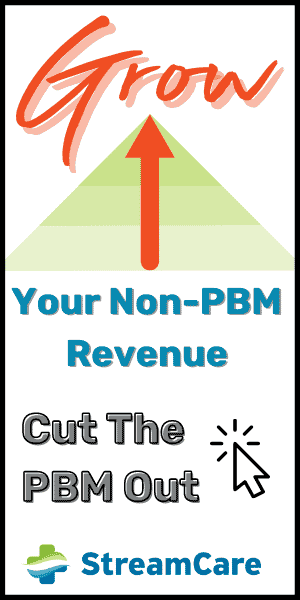If you are like most pharmacy owners, I am betting you don’t do any financial forecasting for your pharmacy.
Let’s dive into why you should.
Luckily for most pharmacies, business is steady from month to month. There aren’t typically huge swings in revenue. This stability is a double-edged sword. On the good side is predictability for employee scheduling and resources for operations. On the negative side are complacency and negative financial surprises. If you are a stressed-out pharmacy owner, financial forecasting is the critical tool you should be using to predict future revenues, expenses, and profits.
Without accurate financial forecasting, it’s impossible to understand how much money will be available to allocate toward investments and expenses related to operations and expansion… aka flying blind. Financial forecasting isn’t just an important tool for survival; it’s essential to thrive in a competitive and rapidly evolving world of pharmacies.
Financial forecasting for pharmacies can actually be pretty easy. If you or your accountant use an online financial tool such as Quickbooks, predicting future months is as hard as copy and pasting.
How Financial Forecasting Breeds Certainty
Financial forecasting involves using historical data and trends to make informed predictions about a pharmacy’s future financial performance. Completing this process is vital for several reasons:
1. Business Sustainability
Looking into the future of your financials is akin to having tsunami warning buoys in the ocean. It helps identify potential money shortages early so you can adjust before the storm. Since cash flow is the main stressor for pharmacy owners, knowing ahead of time if you will fall short allows you to take action before you are in a bind.
2. Budgeting and Resource Allocation
Financial forecasting allows pharmacy owners to create accurate budgets. Clarity will enable pharmacies to allocate resources and employees effectively. While pharmacy is generally stable, some events can cause disruptions. Events such as employee pregnancy, vacations, flu season, or local music festivals are examples.
Accurate forecasting prevents resource shortages or overallocation, allowing pharmacies to maintain smooth operations and provide consistent services to patients.
3. Risk Management
Financial forecasting helps pharmacy owners identify potential financial risks early. Risks can be related to changes in reimbursement rates, fluctuations in demand, and shifts in patient demographics.
The biggest risk pharmacy has faced in recent memory is the DIR Fee Apocalypse coming in January 2024. Many pharmacy owners are worried (as they should be). However, with financial forecasting, you can predict the financial impact of the DIR changes in 2024 and know exactly any shortfalls that you can expect. This knowledge allows you to create an implementable plan of action rather than just hoping and praying.
The Role of Key Performance Indicators (KPIs) in Financial Forecasting
To create accurate financial forecasts, pharmacies must rely on relevant and reliable data; this is where KPIs come into play. KPIs are quantifiable metrics that measure various aspects of a pharmacy’s operations. When chosen wisely, KPIs provide the necessary data for forecasting. Here are some key KPIs that pharmacies should focus on for effective financial forecasting:
1. Revenue Growth Rate
The revenue growth rate KPI measures the percentage increase or decrease in a pharmacy’s revenue over a specific period. Monitoring this KPI helps pharmacies gauge their financial health and identify trends in revenue generation. If you grow by 2% each month, it is easy to predict next month’s revenue. Or, if your growth rate suddenly declines, you can make changes to help your pharmacy operations acclimate to the changes before you lose money.
Why It Matters: A strong revenue growth rate indicates that the pharmacy is attracting new customers or increasing sales to existing ones. Conversely, a decline may signify problems that need addressing, such as changes in customer behavior or market competition.
How to Use It: Analyze historical revenue growth rates and project future growth based on current trends. Identify the factors contributing to growth or decline and adjust strategies accordingly. For instance, if a particular product category has fueled growth, consider expanding that category or promoting similar products.
2. Gross Profit Margin
The gross profit margin is the percentage of revenue that remains after subtracting the cost of goods sold (COGS). This KPI provides insight into a pharmacy’s profitability at the most basic level. A healthy gross profit margin indicates that a pharmacy is effectively managing its ingredient costs and pricing strategies.
Why It Matters: A strong gross profit margin ensures that a pharmacy has enough funds to cover operating expenses and invest in growth. A declining margin may suggest issues with pricing, supplier costs, or inventory management.
How to Use It: Continuously monitor the gross profit margin and compare it to industry benchmarks. Identify areas where costs can be reduced or where pricing strategies can be optimized. For example, negotiating better terms with suppliers or adjusting prices for high-margin products can improve the margin.
3. Inventory Turns
Efficient inventory management is crucial for pharmacies. The inventory turnover rate measures how quickly a pharmacy sells its inventory and replaces it with new stock. A higher turnover rate indicates that a pharmacy is efficiently managing its inventory, reducing carrying costs, and improving its cash flow.
Why It Matters: An optimal inventory turnover rate ensures that capital (the money in your bank account) isn’t tied up in excess inventory. A low turnover rate can lead to cash flow problems and increased carrying costs.
How to Use It:
- Calculate the inventory turnover rate by dividing the cost of goods sold (COGS) by the average inventory value during a specific period. If you need help with this, we are happy to help.
- Analyze this rate to determine if inventory levels are appropriate. If cash is tight, you should aim to increase your inventory turns.
- Adjust ordering and stocking strategies to maintain an optimal turnover rate.
4. Operating Expenses Ratio
This ratio measures the percentage of revenue used to cover operating expenses. It includes costs such as salaries, rent, utilities, and marketing. Monitoring this KPI helps pharmacy owners ensure that their costs are in line with their revenue and make adjustments if necessary.
Why It Matters: A high operating expenses ratio may indicate inefficiencies in cost management, potentially impacting profitability. A lower ratio suggests efficient operations.
How to Use It: Regularly review and analyze the operating expenses ratio. Identify areas where expenses can be reduced or optimized. For example, consider renegotiating leases, implementing cost-effective marketing strategies, or optimizing staff scheduling to reduce labor costs.
5. Patient Acquisition Cost (PAC)
PAC measures how much it costs to acquire a new patient. This KPI is essential for assessing the effectiveness of marketing and patient acquisition strategies. A lower PAC indicates that the pharmacy is procuring patients efficiently.
Why It Matters: High PAC can lead to unsustainable patient acquisition costs, reduced profitability, and stagnant growth. Understanding PAC helps pharmacy owners allocate marketing budgets effectively.
How to Use It:
- Calculate PAC by dividing the total marketing and sales expenses by the number of new patients acquired during a specific period.
- Continuously analyze the PAC to determine the efficiency of marketing campaigns and channels.
- Focus on channels that provide a lower PAC while maintaining or improving customer quality.
6. Average Transaction Value (ATV)
ATV measures the average amount spent by a patient during a single transaction. By tracking this KPI, pharmacies can identify opportunities to increase revenue per patient, such as upselling or cross-selling.
Why It Matters: Increasing the ATV can boost overall revenue without necessarily acquiring more patients. It’s a strategy for growing the business from within.
How to Use It: Analyze historical ATV data and identify trends. Implement strategies to increase ATV, such as offering product bundles, loyalty programs, or personalized recommendations.
Financial forecasting serves as a foundational tool for the success of any independent pharmacy by providing pharmacy owners with a clear picture of their pharmacy’s financial health and operational efficiency. Your bookkeeper or accountant should provide forecasting as a part of their services. If they aren’t, we recommend talking to them about getting them.
Ultimately, it really isn’t the report that is valuable; it is the thought process and deep-dive thinking that goes into producing the report that will help pharmacy owners thrive.
If your cash flow isn’t where you would like it to be… If you are stressed about your wholesaler bills, payroll commitments, or paying yourself, you are not alone. Cash flow is the #1 problem for pharmacy owners. That is why we have created Pharmacy Badass University. After working with thousands of pharmacies and owning a few myself, We have plotted out the proven success path that pharmacy owners can follow to improve cash flow and profits. Check out our membership options HERE.
















